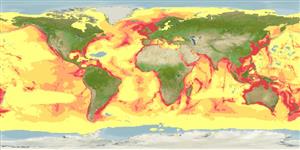Common names from other countries
Environment: milieu / climate zone / depth range / distribution range
Ecologia
Pelágico(a,os,as); oceanódromo (Ref. 75906); intervalo de profundidade 0 - 1316 m (Ref. 116169). Tropical; 90°N - 90°S, 180°W - 180°E
Atlantic Ocean, Indo-Pacific and Mediterranean and Black Sea. Tropical to temperate.
Length at first maturity / Tamanho / Peso / Idade
Maturity: Lm ?, range 240 - 260 cm Max length : 380 cm TL macho/indeterminado; (Ref. 1394); Peso máx. publicado: 650.0 kg (Ref. 1394)
Descrição breve
Morfologia
This coastal subspecies (Tursiops truncatus geyphyreus) can be distinguished from the nominate offshore subspecies (Tursiops truncatus truncatus) by the following diagnosable cranial features: W-shaped border of the antorbital notch (vs. U-shaped); barely or not visible interparietal bone (vs. clearly visible); cranial vertex from the posterior end of nasals to the nuchal crest is short and rectangular (vs. long and squared); left nasal bone noticeably smaller and more compressed antero-posteriorly than the right (vs. nearly symmetrical); Falciform lateral margin of the ascending process of right premaxilla (vs. straight or slightly concave); lateral margin of the ascending process of the maxillae over the preorbital process is deflected dorsally (vs. flat) (Ref. 128824).
Preyed upon by great white sharks (Ref. 32140). Dolphins are directly caught for use as shark-bait in Sta. Ana and Aparri, Philippines (Ref. 77119). Found primarily in coastal and inshore regions of tropical and temperate waters of the world (Ref. 936) and deeper channels between islands (Ref. 122680). Also inhabits pelagic waters, such as those in the eastern tropical Pacific (Ref. 936). In herds of less than 20 individuals (Ref. 801). Feeds either cooperatively or in solitary. They can obtain prey via 'fish whacking' and steering fish onto mudflats (Ref. 122680). Feeds on fish (Refs. 801, 936) crustaceans, and cephalopods (Ref. 801).
Tan, J.M.L. 1995. (Ref. 936)
Categoria na Lista Vermelha da IUCN (Ref. 130435)
Categoria CITES (Ref. 108899)
Utilização humana
Pescarias: espécies comerciais; isco: usually
FAO - pescarias: landings, perfil da espécie | FishSource | Sea Around Us
Ferramentas
Fontes da internet
Estimates based on models
Preferred temperature
(Ref.
115969): 6.4 - 28.9, mean 20.3 (based on 16698 cells).
Resiliência
Elevada, tempo mínimo de duplicação da população menor que 15 meses (K=0.14-0.48; tm=8.5).
Vulnerabilidade
High to very high vulnerability (67 of 100).
Categoria de preço
Unknown.
